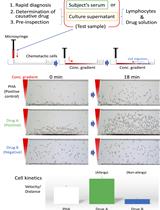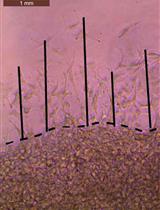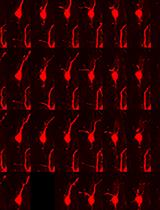- Submit a Protocol
- Receive Our Alerts
- EN
- EN - English
- CN - 中文
- Protocols
- Articles and Issues
- For Authors
- About
- Become a Reviewer
- EN - English
- CN - 中文
- Home
- Protocols
- Articles and Issues
- For Authors
- About
- Become a Reviewer
Extravillous Trophoblast Migration and Invasion Assay
Published: Vol 3, Iss 15, Aug 5, 2013 DOI: 10.21769/BioProtoc.840 Views: 10506
Reviewed by: Fanglian He

Protocol Collections
Comprehensive collections of detailed, peer-reviewed protocols focusing on specific topics
Related protocols

HiSAT: A Novel Method for the Rapid Diagnosis of Allergy
Hirotomo Shibaguchi and Yuki Yasutaka
Feb 5, 2022 1426 Views

Spherical Invasion Assay: A Novel Method to Measure Invasion of Cancer Cells
Stephen D. Richbart [...] Piyali Dasgupta
Feb 20, 2022 3128 Views

Analysis of Mouse Brain Sections by Live-cell Time-lapse Confocal Microscopy
Tao Yang [...] Bing Ye
Apr 5, 2023 480 Views
Abstract
Extravillous trophoblast (EVT) migration and invasion through the decidualized endometrium is essential to successful placentation. SGHPL-4 cells, an EVT cell line derived from first trimester placenta, is a widely used model of cytotrophoblast differentiation into an invasive phenotype. Here we describe a quantitative cell migration assay that can be modified to also measure cell invasion. SGHPL-4 cells were seeded into BD Fluoroblok cell culture inserts constructed with an 8 μm porous membrane and allowed to migrate towards epidermal growth factor, a known chemoattractant for EVTs. To assess EVT invasion, Fluoroblok inserts were first coated with Matrigel, a basement membrane matrix. SGHPL-4 cells were labeled with calcein AM and cells that had invaded and/or migrated across the membrane were quantified by a bottom-reading fluorescence plate reader. The advantage of the Fluoroblok inserts over other migration/invasion assays is that they allow nondestructive detection of migrated cells.
Materials and Reagents
- SGHPL-4 cells (Kindly provided by Dr. Guy Whitley, St. George’s University of London)
- Ham’s F10 Nutrient Mix (Life Technologies, InvitrogenTM, catalog number: 11550-043 )
- Fetal bovine serum (FBS)
- Dulbecco’s Phosphate-Buffered Saline (DPBS) without Ca2+ and Mg2+ (Life Technologies, InvitrogenTM, catalog number: 14190 )
- TrypLE Express (Life Technologies, InvitrogenTM, catalog number: 12604013 )
- Matrigel, Growth Factor Reduced, Phenol Red Free (BD Biosciences, catalog number: 356231 )
- Recombinant Human Epidermal Growth Factor (hEGF) (BD Biosciences, catalog number: 354052 )
- BD Falcon HTS FluoroBlok Inserts (BD Biosciences, catalog number: 35112 )
- Calcein AM (Life Technologies, InvitrogenTM, catalog number: C3100MP )
- Hank’s balanced salt soution (HBSS) (Life Technologies, InvitrogenTM, catalog number: 14025 )
Equipment
- Centrifuge
- 37 °C, 5% CO2 Cell culture incubator
- Inverted Fluorescent Microscope
- Fluorescent plate reader
Procedure
DAY 1
- For Invasion Assay, pre-Coat Fluoroblok Filter (8 μm porous membrane)
- Prechill Fluoroblok inserts, companion plates and pipet tips to help maintain Matrigel in the liquid state.
- Place desired number of prechilled inserts into a 24-well companion plate.
- Add 50 μl of 1:10 Matrigel (diluted in HamF10) to each transwell insert.
- Incubate at 37 °C, 3 h.
- Prechill Fluoroblok inserts, companion plates and pipet tips to help maintain Matrigel in the liquid state.
- Serum starve cultures (70-75% confluent) for 24 h in 0.5% FBS/HamF10
- Aspirate media.
- Wash with 7 ml warm DPBS (without Ca2+ and Mg2+).
- Add 12 ml warm 0.5% FBS/HamF10.
- Incubate cells for 24 h at 37 °C.
- Aspirate media.
DAY 2
- Prepare cells (Upper Chamber)
- Rinse cells once with 10 ml DPBS (without Ca2+ and Mg2+); add 3 ml TrypLE Express and incubate at 37 °C for 3-5 min; add 7 ml 0.5% FBS/HamF10 →10 ml total.
- Count cells using a hemacytometer.
- In a 50 ml conical tube, centrifuge cells at 300 x g for 10 min.
- Remove supernatant and resuspend cells in 0% FBS/HamF10 to obtain a cell suspension concentration of 1.2 x 106 cells/ml (or 1,250 cells/μl).
- Cap tube and store at room temperature till ready to load in chamber.
- Rinse cells once with 10 ml DPBS (without Ca2+ and Mg2+); add 3 ml TrypLE Express and incubate at 37 °C for 3-5 min; add 7 ml 0.5% FBS/HamF10 →10 ml total.
- Prepare the chemoattractant (Treatments in Bottom Chamber)
- Dilute desired chemoattractant in 0% FBS/HamF10. You will need 800 μl per well.
- Prepare 10 ng/ml EGF as positive control.
- Add 800 μl of chemoattractant to the bottom of each well. Avoid bubbles.
- Dilute desired chemoattractant in 0% FBS/HamF10. You will need 800 μl per well.
- Assemble invasion chamber
- Using a forceps, carefully remove insert from empty well.
- Add 200 μl of cells (2.5 x 105 for Invasion Assay or 5 x 104 for Migration Assay) to Matrigel-coated (for Invasion Assay) or uncoated insert (for Migration Assay).
- Lower the insert at an angle into the well containing the chemotactic substance. Check for bubbles by looking under the plate. If there are bubbles, remove insert and try again.
- Incubate at 37 °C for 12 h for Cell Migration Assay or 20-22 h for Cell Invasion Assay.
- Using a forceps, carefully remove insert from empty well.
DAY 3
- After invasion period, label invaded cells (on lower side of filter) with Calcein AM. For each well, add 2 μl of Calcein AM to 500 μl of HBSS.
- Carefully aspirate the media from the insert, without disturbing the Matrigel layer.
- Transfer the insert to a fresh well containing Calcein AM/HBSS solution.
- Incubate at 37 °C for 1 h in the dark.
- Read plate on fluorescent plate reader at 520 nm or take pictures using an epifluorescent microscope.
Acknowledgments
This protocol is adapted from Angelova et al. (2012).
References
- Angelova, M., Zwezdaryk, K., Ferris, M., Shan, B., Morris, C. A. and Sullivan, D. E. (2012). Human cytomegalovirus infection dysregulates the canonical Wnt/beta-catenin signaling pathway. PLoS Pathog 8(10): e1002959.
- LaMarca, H. L., Ott, C. M., Honer Zu Bentrup, K., Leblanc, C. L., Pierson, D. L., Nelson, A. B., Scandurro, A. B., Whitley, G. S., Nickerson, C. A. and Morris, C. A. (2005). Three-dimensional growth of extravillous cytotrophoblasts promotes differentiation and invasion. Placenta 26(10): 709-720.
- Warner, J. A., Zwezdaryk, K. J., Day, B., Sullivan, D. E., Pridjian, G. and Morris, C. A. (2012). Human cytomegalovirus infection inhibits CXCL12- mediated migration and invasion of human extravillous cytotrophoblasts. Virol J 9: 255.
Article Information
Copyright
© 2013 The Authors; exclusive licensee Bio-protocol LLC.
How to cite
Angelova, M., Machado, H. L., Swan, K. F., Morris, C. and Sullivan, D. E. (2013). Extravillous Trophoblast Migration and Invasion Assay. Bio-protocol 3(15): e840. DOI: 10.21769/BioProtoc.840.
Category
Cell Biology > Cell movement > Cell migration
Do you have any questions about this protocol?
Post your question to gather feedback from the community. We will also invite the authors of this article to respond.
Tips for asking effective questions
+ Description
Write a detailed description. Include all information that will help others answer your question including experimental processes, conditions, and relevant images.
Share
Bluesky
X
Copy link







